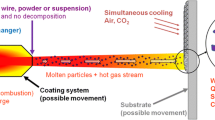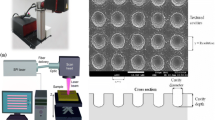Abstract
Laser-material interactions consist of complex, and generally short-lived, but intense events. Hence, many important aspects and effects of these interactions are not directly measurable, such as temperature distributions within the material. In the present study, the effect of temperature distribution on the residual stresses developed during laser surface engineering of ceramic composite coating on metal has been investigated. Infrared thermography technique has been employed as a means to measure the temperature distribution within the substrate while the laser beam is directed at the surface of the coating. Temperature distribution is generally a function of the laser input parameters, such as the laser beam power and the traverse velocity of the beam. Hence, variation in the temperature distribution and the consequent stresses developed within the composite coating due to the changing input parameters have also been investigated. The rapid processing in complement with precise control of the process based on in-situ thermographic measurements provides numerous opportunities for a high power laser as a advanced manufacturing tool.







Similar content being viewed by others
Abbreviations
- φ :
-
Azimuthal angle
- Ψ :
-
Tilt Angle
- Q :
-
Heat energy
- t :
-
Time
- T :
-
Temperature
- k :
-
Thermal conductivity
- ρ :
-
Density
- C p :
-
Heat capacity
- ε :
-
Strain
- d :
-
Interplanar spacing
- ν :
-
Poisson’s ratio
- E :
-
Young’s modulus
- σ :
-
Stress
References
Komvopoulos K, Nagarathnam K (1990) J Engin Mater Technol 112:131–143
Komanduri R, Hou ZB (2001) Thermal analysis of the laser surface transformation hardening process. Int J Heat Mass Trans 44:2845–2862
Agarwal A, Dahotre NB (2000) Wear behavior of composite boride coating on steel using high energy density processes: a comparative study. Wear 240:144–151
Stern KH (ed) Metallurgical and ceramic protective coatings. Chapman & Hall, London
Zhou XB, De Hosson JTM (1991) Reactive wetting of liquid metals on ceramic substrates. Scrip Mater 25:2007–2010
Kesler O, Matejicek J, Sampath S, Suresh S, Gnaeupel-Herold T, Brand PC, Prask HJ (1998) Measurement of residual stresses in plasma-sprayed metallic, ceramic, and composite coatings. Mat Sci Engin A257:215–224
Cline HE, Anthony TR (1977) The effect of harmonics on the capillary instability of liquid jets. J Appl Phys 48:3895–3900
Dowden J, Davis M, Kapadia P (1985) J Appl Phys 57:4474–4479
Chande T, Mazumder J (1984) Mass transport in laser surface alloying: iron-nickel system. J Appl Phys 56:1981–1986
Kou S (1981) Metall Trans A 12A:2025–2030
Kadolkar P, Dahotre NB (2002) Appl Surf Sci 199:222–233
Kadolkar P (2002) Residual stress and cohesive strength of TiC composite coating on aluminum alloys during laser surface engineering. Master’s thesis, University of Tennessee
Lang G (1972) Aluminum 48:664–672
Brandt O, Wandelt M (1996) In: Proceedings of the 9th National Thermal Spray Conference, Cincinnati, OH
Noyan IC, Cohen JB (1987) Residual stress, measurement by diffraction and interpretation. Springer, Berlin Heidelberg New York
American Society of Metals (1988) ASM Metals Handbook, vol 2
Bhushan B, Gupta BK (1991) Handbook of tribology, materials coatings, and surface treatments. McGraw-Hill, New York
Abuhasan A, Balasingh C, Predecki P (1990) J Amer Ceram Soc 73:2474–2484
Rosenthal C (1941) J Weld 20:220–234
Kou S, Hsu SC, Mehrabian R (1981) Metall Trans B 12B:33–44
Kingery WD, Bowen HK, Uhlmann DR (1976) Introduction to ceramics. Wiley-Interscience, Cambridge
Vreeling JA, Pei YT, Wind B, Ocelik V, De Hosson JTM (2001) Script Mater 44:643–649
Cohen JB (1986) Powd Diff 1:15–21
Noyan IC, Cohen JB (1985) Mat Sci Engin 75:179–193
Acknowledgements
The authors would like to acknowledge the residual stress measurement and infrared thermography sponsored by the Assistant Secretary of Energy Efficiency and Renewable Energy, Office of Transportation Technologies, as part of the High Temperature Materials Laboratory User Program, Oak Ridge National Laboratory, managed by UT-Battelle, LLC, for the U.S. Department of Energy, under the contract number DE-AC05-00OR22725.
Author information
Authors and Affiliations
Corresponding author
Rights and permissions
About this article
Cite this article
Kadolkar, P., Wang, H., Watkins, T.R. et al. Thermographic characterisation of a laser surface engineered ceramic coating on metal. Int J Adv Manuf Technol 23, 350–357 (2004). https://doi.org/10.1007/s00170-003-1675-1
Received:
Accepted:
Published:
Issue Date:
DOI: https://doi.org/10.1007/s00170-003-1675-1




